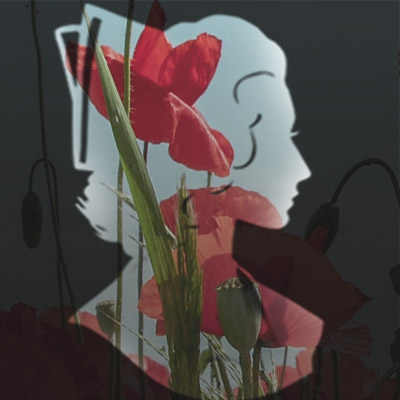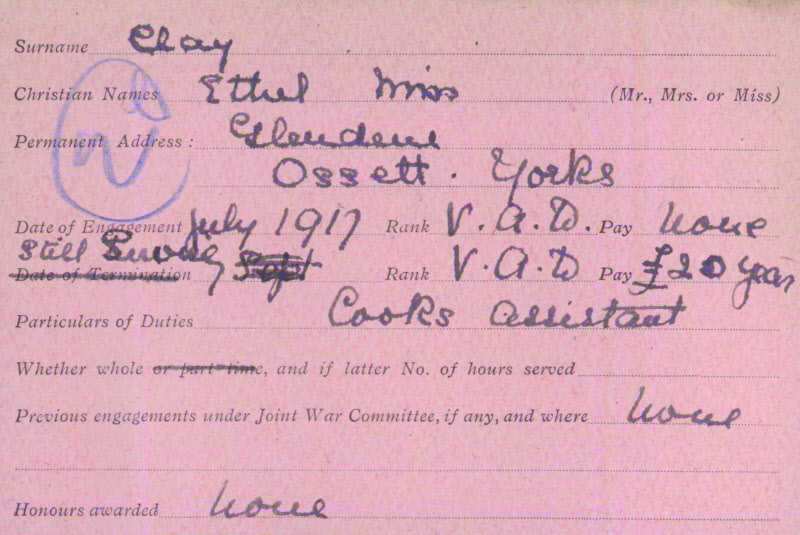
Ethel Mary Clay was born in Dewsbury in early 1878, the third child and only daughter of Earlsheaton born wool merchant, William Clay and his wife Elizabeth (nee Riley) who were married in Oldham in early 1870. The couple had six children from their marriage, but sadly two had died before 1911.
In 1881, William and Oldham born, Elizabeth were living at West Park Street, Dewsbury, with the three of their children, including Ethel, born by the time of the 1881 Census. The family had a 21 year-old domestic nurse supporting Elizabeth to care for their children, who were all under the age of 10 years.
By 1891, William and Elizabeth, now with four children, including Ethel, a scholar, and the only girl in the family, had moved to Oxford Road, Dewsbury. The eldest son, Sidney Herbert, was born in 1872 and in 1891 was articled to a solicitor. The second son, Reginald was born in 1873 and was working as a wool merchant, whilst the third son and youngest child, William Bernard, was born in 1881. William and Elizabeth also had two domestic servants to support the family.
In 1901, Ethel Clay was 23 years of age and visiting her 75 year old widowed grandmother, Elizabeth Riley, a woman of independent means who was living in Chadderton near Oldham in Lancashire. Two servants, a housemaid and a cook, were recorded in the household. Meanwhile Ethel’s parents, William and Elizabeth were still living on Oxford Road, Dewsbury, but none of their children were living at home at the date of the census. The couple had a domestic servant and William was working as a wool merchant salesman. Unlike earlier censuses, when he was recorded as an employer, in 1901, he was recorded as a “worker.”
By 1911, William and Elizabeth Clay, by now in their late 60s, were living in a nine-roomed home, “Glendene”, on Station Road. Ossett. Ethel was their only child remaining with them in the family home. The household included a domestic servant. In common with earlier census records Ethel, now aged 33 years, appears not to have had an occupation.

Above: Station Road, opened in 1889 at a cost of £7,000 and linked Ossett Market Place with Manor Road.
In July 1917 Ethel Clay of “Glendene”, Ossett volunteered to serve with the Voluntary Aid Detachment (VAD) and worked as a volunteer cook’s assistant at Spring Hall VAD Auxiliary Hospital Halifax. She was still serving as late as 1919 by which time she was being paid £20 p.a.


Above: Miss Ethel Clay’s VAD record cards.
The Red Cross and The Order of St John of Jerusalem organised voluntary aid detachments (VADs), made up of men and women, in every county to carry out transport duties and staff rest stations and hospitals. By October 1910, 202 detachments had been registered with over 6,000 volunteers. Membership of the detachments grew still further on the outbreak of the First World War when the Joint War Committee was formed.
VADs had to be between 23 and 38 years old. Women under 23 were rarely registered as nurses with the Red Cross, but the rule was not enforced for women over 38 who had no diminished capacity.
Spring Hall, Halifax operated as a WW1 84 bed VAD Auxiliary Hospital between 1st February 1916 until 28th February 1918 . In April 1917 an annexe was constructed to provide an additional 116 beds. An advertisement in August 1916 announced1:
SPRING HALL CONVALESCENT HOME
Tomorrow (Sunday) Evening
GRAND CONCERT
by
SHIBDEN SCHOOL BOYS MILITARY BAND
Auxiliary Hospitals, established and operated under the auspices of The Red Cross which had secured buildings, equipment and staff. Thus the organisation was able to set up temporary hospitals as soon as wounded men began to arrive from abroad. The buildings varied widely, ranging from town halls and schools to large and small private houses, both in the country and in cities. The most suitable ones were established as auxiliary hospitals. There were over 3,000 auxiliary hospitals administered by Red Cross county directors.
In many cases, women in the local neighbourhood volunteered on a part-time basis. The hospitals often needed to supplement voluntary work with paid roles, such as cooks. Local medics also volunteered, despite the extra strain that the medical profession was already under at that time. The patients at these hospitals were generally less seriously wounded than at other hospitals and they needed to convalesce. The servicemen preferred the auxiliary hospitals to military hospitals because they were not so strict, they were less crowded and the surroundings were more homely.
At an early stage of the war women began to be invited to serve in a range of capacities, of which nursing was one. Thousands of young women from middle-class homes with little experience of domestic work, not much relevant education and total ignorance of male bodies, volunteered and found themselves pitched into hospital environments. Those women who joined the VAD could be trained, in cookery, sanitation, bandaging and dressings, washing of bodies and linens, and proper procedure before, during, and after surgeries. To become a VAD Member, a woman would write to her Country Director for instructions, or to the Secretary of the Joint Women’s VAD Department, which was stationed inside Devonshire House, who would then forward the name of her local County Director.
It is not certain whether any of Ethel’s brothers served in WW1 but two of them, Sidney and Reginald, were over the age of 40 when the War began in August 1914. What is certain however is that they were all still alive by the time of the 1918 Armistice.
Ethel’s eldest brother, solicitor, Sydney Herbert married Beatrice Mary Charlotte Mudford at Retford in 1907. Sydney Herbert of Crescent House, Retford died at Addenbrookes Hospital in August 1946. He left £161,975.
her elder brother, Reginald, married Annie Leonara (aka Nora) Kilner, the daughter of Barron Kilner, a glass manufacturer born in Thornhill Lees who was the grandson of John Kilner who invented the Kilner Jar in the 1840s. Sadly, Reginald died in Batley in March 1924 at the age of only 51 years. He left an estate worth £43,141 and his solicitor brother, Sidney Herbert, was granted Probate. Ethel’s youngest brother, William Bernard also suffered misfortune having married in Belfast in 1909, his young wife, Georgina McCauley, died in 1915 aged 31 years. He re-married, Elsie Mary Mitchell, in 1921 and lived until 1965 when he died at Keighley aged 82. He left £35,846.
In 1904,Ethel’s family history and her work in the VAD confirms the view that V.A.D.s, initially were mostly middle-class women eager to “do their bit,” performed a variety of duties. At home the organisation administered auxiliary hospitals and convalescent homes and much of the V.A.D. service consisted of general nursing duties and administering first aid. Qualified nurses were also employed to work in these establishments. In addition, clerical and kitchen duties were performed by V.A.D.s, and as many men were engaged in military service, female V.A.D.s took on roles such as ambulance drivers, civil defence workers and welfare officers.
Sadly, Ethel Mary Clay died on 18th April 1929, aged only 51. Ethel never married, but by the time of her death she had moved to The Gables, Wakefield Road, Dewsbury. Probate of her estate was granted, in London on 2nd July 1929, jointly to her two surviving brothers, Sidney Herbert, solicitor, and William Bernard, engineer. Her effects were £16,456 4s 11d.
References